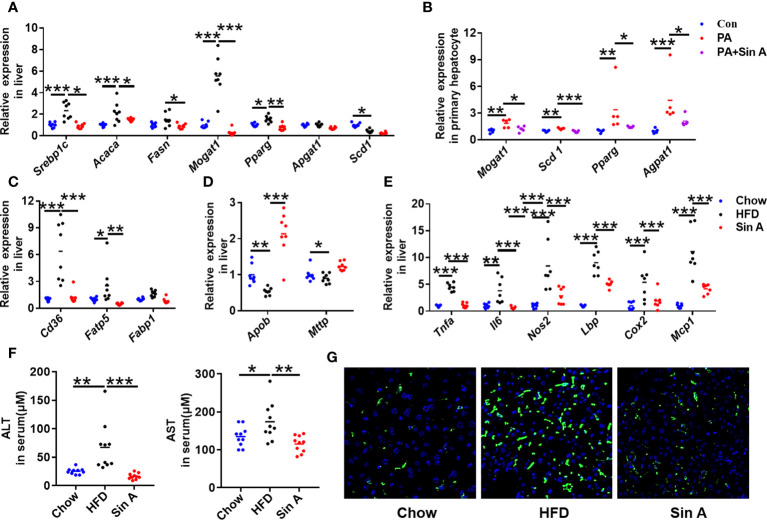Figure 2.
Sin A attenuates hepatic lipid accumulation and inflammatory response in NAFLD mice. Chow-fed mice were treated daily with normal diet (Chow). HFD-fed mice were orally treated with vehicle (HFD) or Sin A (80 mg/kg, Sin A) for 6 weeks. (A) The key gene expression associated with fatty acid biogenesis in liver. (B) Fatty acid biogenesis-related genes in primary hepatocytes with palmitic acid or Sin A incubation for 24 h (n=5 per group). The gene expression associated with fatty acid uptake (C) and LDL-C export (D) in liver sections. (E) The expression levels of inflammation response-related genes in liver (n=6 per group). (F) Changes in serum chemistry (ALT and AST) of mice (n=10 per group). (G) The representative images of F4/80 staining in the liver (Scale bars 100 μm). Values are expressed as means ± SD. Statistical significance were determined by one-way ANOVA for the multiple-group comparisons. p*<0.05; **p<0.01; ***p<0.001. Srebp-1c, sterol regulatory element binding protein-1c; Acaca, acetyl-CoA carboxylases alpha; Fasn, fatty acid synthase; Mogat1, Monoacylglycerol O-acyltransferase 1; Pparg, peroxisome proliferative activated receptor, gamma; Scd-1, stearoyl-coenzyme A desaturase-1; Cd36, cluster of differentiation 36; Fatp5, fatty acid transport protein 5; Fabp1, fatty acid-binding protein1; Apob, apolipoprotein B; Mttp, microsomal triglyceride transfer protein; Tnfa, tumor necrosis factor α; Il6, interleukin 6; Nos2, Nitric Oxide Synthase2; Lbp, Lps-binding protein; Cox2, Cyclooxygenase-2; MCP-1, Monocyte chemoattractant protein-1; ALT, Alanine Aminotransferase; AST, Aspartate Aminotransferase.

